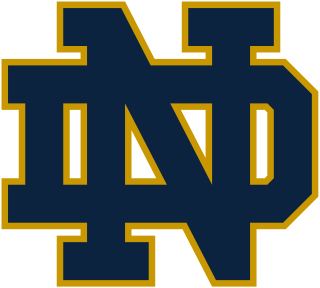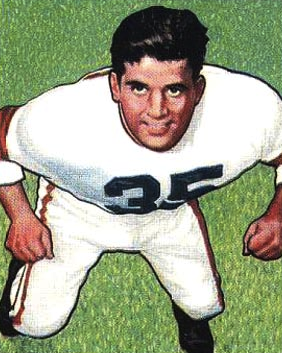
Ara Raoul Parseghian was an American football player and coach who guided the University of Notre Dame to national championships in 1966 and 1973. He is noted for bringing Notre Dame's Fighting Irish football program back from years of futility into national prominence in 1964 and is widely regarded alongside Knute Rockne and Frank Leahy as a part of the "Holy Trinity" of Notre Dame head coaches.

The Notre Dame Fighting Irish football team is the intercollegiate football team representing the University of Notre Dame in Notre Dame, Indiana, north of the city of South Bend, Indiana. The team plays its home games at the campus' Notre Dame Stadium, which has a capacity of 80,795. Notre Dame is one of four schools that competes as an Independent at the National Collegiate Athletic Association (NCAA) Football Bowl Subdivision (FBS) level; however, they play five games a year against opponents from the Atlantic Coast Conference (ACC), of which Notre Dame is a member in all other sports except ice hockey.

Alexander Arrasi Agase was an American football guard and linebacker who was named an All-American three times in college and played on three Cleveland Browns championship teams before becoming head football coach at Northwestern University and Purdue University.

The Northwestern Wildcats football team represents Northwestern University as an NCAA Division I college football team and member of the Big Ten Conference based near Chicago in Evanston, Illinois. Founded in 1851, Northwestern began playing football in 1882. Its football mascot is the Wildcat, a term coined by a Chicago Tribune reporter in 1924, after reporting on a football game where the players appeared as "a wall of purple wildcats". Northwestern Football is also marketed as "Chicago's Big Ten Team" with its proximity and ties to Chicago.

The Notre Dame–Purdue football rivalry is an American college football rivalry between the Notre Dame Fighting Irish football team of the University of Notre Dame and Purdue Boilermakers football of Purdue University.

The Purdue Boilermakers football team represents Purdue University in the NCAA Football Bowl Subdivision (FBS) of college football. Purdue plays its home games at Ross–Ade Stadium on the campus of Purdue University in West Lafayette, Indiana. The head coach of Purdue is Ryan Walters, the 37th head coach in Purdue history. The Boilermakers compete in the Big Ten Conference as a member of the West Division. Purdue had most recently been a part of the Leaders Division of the Big Ten, but moved to the West Division in 2014 due to conference expansion.

The Miami RedHawks football program represents Miami University, located in Oxford, Ohio, in college football at the NCAA Division I FBS level. The RedHawks compete in the Mid-American Conference and are known for producing several high-profile head coaches, earning it the nickname "Cradle of Coaches". The team is coached by Chuck Martin and plays its home games at Yager Stadium. Miami has the distinction of being the most successful program in the MAC with over 700 all-time wins.

Kenneth Webster "Jack" Mollenkopf was the head football coach at Purdue University from 1956 until 1969. Mollenkopf was also an assistant coach at Purdue from 1947 to 1955 under Stu Holcomb.

Richard Weldon "Doc" Urich was an American football player and coach. He served as the head football coach at University at Buffalo from 1966 to 1968 and at Northern Illinois University from 1969 to 1970, compiling a career record of 24–26.
The 1995 Northwestern Wildcats football team represented Northwestern University in the 1995 NCAA Division I-A college football season. The 1995 season was a highly memorable one for the Northwestern program, as the Wildcats went 10–2 overall and 8–0 in the Big Ten Conference, earning their first winning season since 1971, their first conference championship since 1936, and their first 10-win season since 1903. They also broke several long-standing losing streaks to regular opponents, including a 22-game losing streak to Iowa, a 19-game losing streak against Michigan, and a 14-game losing streak to Notre Dame.

Robert Eugene Marve is a former American football quarterback who played for the Winnipeg Blue Bombers of the Canadian Football League (CFL). As a high school player, Marve was named Florida's Mr. Football and member of Parade All-American team as senior at Plant High School in Tampa, Florida, after breaking three state season records. Those records included passing yards (4,380), which topped 2007 Heisman Trophy winner Tim Tebow's marks, touchdowns (48) and completions (280). He also led the Panthers to a Class 4A state championship by completing 30 of 46 passes for 305 yards and three touchdowns in the title game.
The 1948 Sun Bowl matched the Texas Tech Red Raiders and the Miami (Ohio) Redskins.

The 2010 Purdue Boilermakers football team represented Purdue University in the 2010 NCAA Division I FBS football season. They played their home games at Ross–Ade Stadium in West Lafayette, Indiana and competed in the Big Ten Conference. It was Danny Hope's second season as head coach. The Boilermakers finished the season 4–8, 2–6 in Big Ten play.
Michael J. Stock is a former American football player and coach. He coached for 26 years at the collegiate level, 17 years in the National Football League (NFL), one year in the United States Football League (USFL), and one year coaching high school football in Ohio; altogether he coached 14 different teams. His career included four and a half seasons, from 1978 to 1982, as the head football coach at Eastern Michigan University, where he coached the Eastern Michigan Hurons through most of a school-record 27-game losing streak.
The 1956 Purdue Boilermakers football team was an American football team that represented Purdue University during the 1956 Big Ten Conference football season. In their first year under head coach Jack Mollenkopf, the Boilermakers compiled a 3–4–2 record, finished in a tie for seventh place in the Big Ten Conference with a 1–4–2 record against conference opponents, and outscored opponents by a total of 139 to 122.
The 1956 Northwestern Wildcats team was an American football team that represented Northwestern University during the 1956 Big Ten Conference football season. In their first year under head coach Ara Parseghian, the Wildcats compiled a 4–4–1 record, finished in sixth place in the Big Ten, and were outscored by their opponents by a combined total of 112 to 107.
The 1974 Notre Dame Fighting Irish football team represented the University of Notre Dame during the 1974 NCAA Division I football season. It was Ara Parseghian's final season as head coach.
The 1964 Big Ten Conference football season was the 69th season of college football played by the member schools of the Big Ten Conference and was a part of the 1964 NCAA University Division football season.
The 1956 Big Ten Conference football season was the 61st season of college football played by the member schools of the Big Ten Conference and was a part of the 1956 college football season.
The 1955 Big Ten Conference football season was the 60th season of college football played by the member schools of the Big Ten Conference and was a part of the 1955 college football season.









